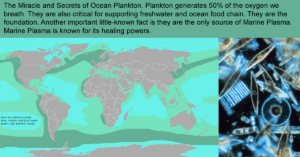Plankton and Their Role in Marine Plasma
Plankton plays a crucial role in the marine ecosystem, and its connection to marine plasma is multifaceted. Marine plasma refers to the fluid component of the blood in marine organisms, which includes various salts, minerals, nutrients, and other essential elements necessary for physiological functions. Here’s how plankton is connected to marine plasma:
 Nutrient Cycling: Phytoplankton, microscopic plant-like organisms, are primary producers in the ocean. They use sunlight to perform photosynthesis, converting carbon dioxide into organic compounds. During this process, phytoplankton absorb essential nutrients from the water, such as nitrogen, phosphorus, and trace elements[i].
Nutrient Cycling: Phytoplankton, microscopic plant-like organisms, are primary producers in the ocean. They use sunlight to perform photosynthesis, converting carbon dioxide into organic compounds. During this process, phytoplankton absorb essential nutrients from the water, such as nitrogen, phosphorus, and trace elements[i].- Zooplankton as Consumers: Zooplankton, which includes small animals like copepods and krill, feed on phytoplankton. Through predation, zooplankton assimilate the nutrients that were initially absorbed by phytoplankton[ii].
- Energy Transfer: The consumption of phytoplankton by zooplankton represents the beginning of the marine food web. As zooplankton is consumed by larger organisms, the energy derived from phytoplankton is transferred up the food chain. This energy transfer is essential for the growth, development, and maintenance of higher trophic levels in the marine ecosystem[iii].
- Oxygen Production: Phytoplankton is a primary source of oxygen production through photosynthesis. During this process, phytoplankton release oxygen as a byproduct, contributing to the oxygen content in the water. Oxygen is vital for the respiration of marine organisms, influencing their metabolic processes and, by extension, the composition of marine plasma. At least half of the oxygen on the earth comes from this process[iv].
- Carbon Sequestration: Phytoplankton plays a role in carbon sequestration by absorbing carbon dioxide during photosynthesis. This not only regulates carbon levels in the ocean but also influences the pH of seawater. The pH of the marine environment can impact the physiological processes of marine organisms, including those related to the composition of their plasma[v].
- Mineral Content: The minerals and trace elements and the amounts thereof present in seawater, some of which are derived from planktonic activity, contribute to the overall composition of marine plasma. These elements, including calcium, magnesium, and various ions, are essential for the proper functioning of physiological processes in marine organisms[vi].
- Biological Interactions: Planktonic organisms, both phytoplankton and zooplankton, engage in complex biological interactions with each other and with larger marine organisms. These interactions influence the overall health and composition of marine plasma in different species[vii].
In summary, plankton, through its role as primary producers, nutrient cyclers, and contributors to oxygen and mineral content in seawater, has a direct and indirect impact on the composition of marine plasma. The intricate relationships between plankton and marine organisms are essential for the functioning of marine ecosystems and highlight the interconnectedness of life in the ocean. Understanding these dynamics is crucial for marine biologists and ecologists studying the health and sustainability of marine environments.
Citations
[i] Prins, Theo & Escaravage, Vincent & Smaal, A.C. & Peeters, J.. (1995). Nutrient cycling and phytoplankton dynamics in relation to mussel grazing in a mesocosm experiment. Ophelia. 41. 289-315. 10.1080/00785236.1995.10422049.
[ii] https://oceantoday.noaa.gov/animalsoftheice_krill/ Accessed 2/27/2024
[iii] Degerman, R., Lefébure, R., Byström, P. et al. Food web interactions determine energy transfer efficiency and top consumer responses to inputs of dissolved organic carbon. Hydrobiologia 805, 131–146 (2018). https://doi.org/10.1007/s10750-017-3298-9
[iv] https://oceanservice.noaa.gov/facts/ocean-oxygen.html Accessed 2/27/24
[v] Divya, M. & , Dr. S. Dinesh Kumar & Krishnaveni, N. & Santhanam, Perumal. (2018). A Study of Carbon Sequestration by Phytoplankton. 10.1007/978-981-10-7938-2_15.
[vi] Twining BS, Baines SB. The trace metal composition of marine phytoplankton. Ann Rev Mar Sci. 2013;5:191-215. doi: 10.1146/annurev-marine-121211-172322. Epub 2012 Aug 28. PMID: 22809181.
[vii] Prairie, Jennifer C., Sutherland, Kelly R., Nickols, Kerry J., Kaltenberg, Amanda M., (2012), Biophysical interactions in the plankton: A cross-scale review. Limnology and Oceanography: Fluids and Environments, 2, 10.1215/21573689-1964713.

